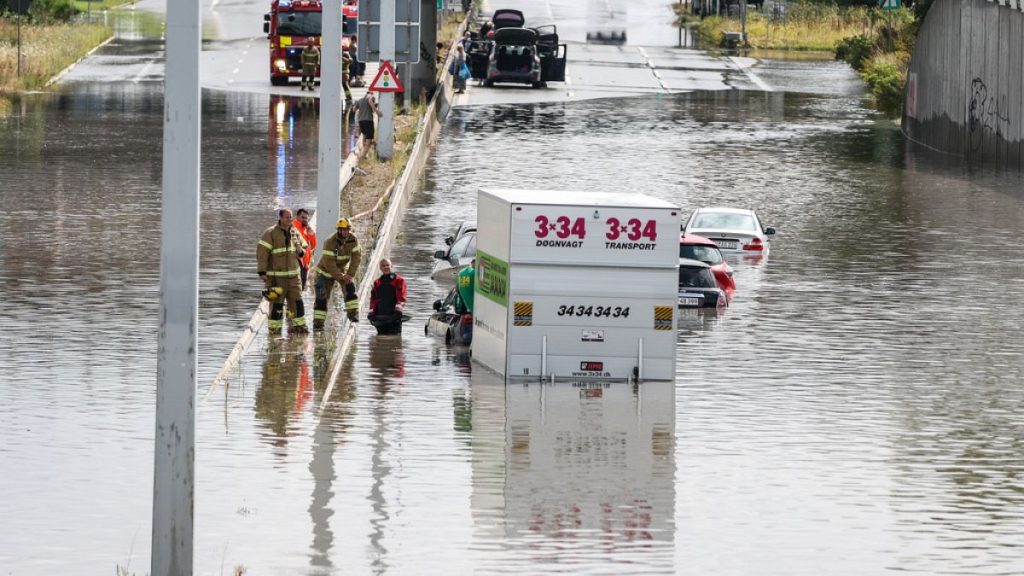The Danish coastal authority has instructed 51 out of the country’s 98 municipalities to develop flood protection plans due to concerns about worsening flooding in the future. This directive comes in the wake of severe flooding in the western part of Denmark over the weekend, caused by over 140 liters of rain per square meter falling in the port city of Esbjerg and surrounding areas. This extreme weather event led to the temporary closure of a motorway near Esbjerg and highlighted the need for increased emergency preparedness in the country. Denmark’s emergency services are calling for more equipment, personnel, and better training in response to the changing climate conditions. According to officials, extreme weather events are becoming more violent and unpredictable, posing new challenges that were not as prevalent five or ten years ago.
The Head of Secretariat of the Danish emergency services, Bjarne Nigaard, emphasized the importance of emergency preparedness as a form of disaster insurance in Denmark. He noted that extreme weather events have become increasingly frequent and severe, requiring a proactive approach to managing the risks associated with such events. Minister for Community Security and Preparedness, Torsten Schack Pederson, also highlighted the changing nature of weather patterns, stating that current extreme weather events were unlike those experienced in the past. The country’s weather service has reported a significant increase in rainfall in recent years, with 972.7 liters of rainfall per square meter recorded in 2023 — the highest amount on record. This trend underscores the need for improved flood protection measures and emergency response capabilities in Denmark.
In response to the recent flooding, emergency teams in Denmark are working to clean up the damage caused by the severe weather event. The focus is on restoring normalcy in the affected areas and ensuring the safety and well-being of residents. The disruptions caused by the flooding, including road closures and property damage, highlight the vulnerability of communities to extreme weather events. As climate change continues to impact weather patterns, Denmark is facing the need for more robust disaster preparedness measures to mitigate the risks associated with flooding and other natural disasters. This includes developing comprehensive flood protection plans and enhancing emergency response capabilities to address the growing challenges posed by extreme weather events.
The Danish coastal authority’s directive to municipalities to develop flood protection plans reflects a proactive approach to addressing the increasing threat of flooding in the country. By requiring local authorities to assess their vulnerability to flooding and implement mitigation measures, Denmark aims to strengthen its resilience to extreme weather events. The shift towards more intense rainfall and flooding in recent years has necessitated a reevaluation of existing emergency preparedness strategies to ensure that communities are adequately protected. With climate change expected to exacerbate the frequency and severity of extreme weather events, Denmark is taking steps to enhance its capacity to respond effectively to emergencies and safeguard the well-being of its citizens.
The call for more equipment, personnel, and better training by Denmark’s emergency services underscores the importance of investing in disaster preparedness and response capabilities. As extreme weather events become more frequent and severe, the need for skilled personnel, specialized equipment, and coordinated response efforts becomes critical. By allocating resources to strengthen emergency services and enhance training programs, Denmark aims to build a more resilient and adaptive system for managing disasters. This proactive approach to emergency preparedness aligns with the country’s commitment to safeguarding public safety and ensuring effective response to natural disasters.
Overall, Denmark’s response to the recent flooding highlights the importance of proactive disaster preparedness and adaptive response strategies in the face of changing climate conditions. By recognizing the evolving nature of extreme weather events and investing in flood protection measures and emergency response capabilities, Denmark is taking steps to mitigate the risks associated with flooding and safeguard communities against future disasters. The country’s focus on enhancing emergency preparedness, improving training, and allocating resources to address the challenges posed by climate change reflects a forward-looking approach to managing the impacts of extreme weather events. By working collaboratively with local authorities, emergency services, and other stakeholders, Denmark aims to build a more resilient and prepared society capable of responding effectively to the changing climate and ensuring the safety and well-being of its citizens.


